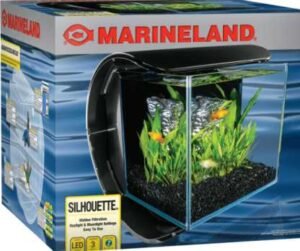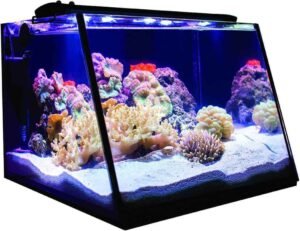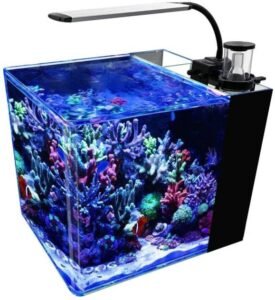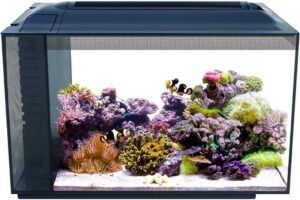start the best saltwater aquarium for beginners, Setting up a new aquarium is often a hard task, but it’s totally worth it once it gets ready.
Many people are tempted by the colorful fish and the perfect looks of corals which are offered in a wide range by saltwater aquariums. This gives us a confusing decision, which kind of aquariums we should start setting up, saltwater, or freshwater.
Table of Contents
saltwater aquarium or Freshwater
There is a wrong concept that saltwater aquarium basics are harder to set up or maintain than freshwater aquariums, which is not totally true In fact, the changes in the environment in the saltwater aquarium affect the health of saltwater fish when compared to freshwater fish.
Does this mean that the saltwater aquarium is worse? no, for sure.
It is not difficult to set up an aquarium full of saltwater fish, it just needs better time management and the need to stay on top of tank maintenance.
When starting setting up a saltwater fish tank, you shouldn’t rush things. You can’t just set up the aquarium, throw the fish and you expect them to survive. the way you set up your tank should be carefully chosen and the environment inside this tank and the fish in it should be suitable. Setting up the tank and the equipment you need isn’t something you can always do in a short time. You should give it the time it needs to get the best results.
saltwater aquarium for beginners setup
Before making any buying decision you have to make sure that you have the right place for your aquarium.
The location of the aquarium shouldn’t be in direct sunlight, which could cause the growth of
algae and it should be away from any window, outside doors.
Temperature is an important factor for fish living, rapid changes in it extremely stressful for all fish especially for saltwater fish.
Don’t forget to check your lease if you rent your home, some homes limit the number of aquariums allowed.
Make sure there is enough space between the wall and the back of the tank to fit your filters and allow easy access for maintenance.
Once the location has been selected it’s time to select the type of tank and how to set it up.
The size of the tank depends on how big you wish your fish to be beside the quantity.
It’s preferable if you start with a large tank especially if you still a beginner. But of course, it’s all
depends on the budget you have. There are many starter kits available in the markets.
- Let we now see how you can set up the tank:
Rinse out the tank to get rid of the dust. - Set the tank stand into a place and make sure there is enough space behind the back of the tank to fit filters and allow easy access for maintenance.
- Fill the tank approximately 1/3 full and check for any leak. If the tank leaks, empty it of water and return it to the market you bought it from and replace it with a good one.
sure that the tank stands well not any small movement makes it susceptible to break.
Most aquariums contain between an inch to two inches, however before adding gravel you should
rinse below it.
If you’re planning on adding any particularly large structures as a part of the ornamental
the aspect of the tank, then it’s a good idea to do so at this stage, ensuring to secure the bottom
of them within the layer of gravel.
If no leaks have been noticed you can now fill the tank with water. start adding commercial salt,
a little at a time. If you have a hydrometer you can keep adding salt until 1.020 of gravity reading.
The best gravity reading is around 1.020 – 1.025 for fish. It may take up to 24 hours for the specific
gravity level to stabilize
Good bacteria is something required to be added to an aquarium to help to convert ammonia to
nitrites then into nitrates, which maintain the tank balance.
When ammonia is added to the tank, it is broken down into nitrite and bacteria, The bacteria break
down the nitrites into nitrates.
- Make a place for the heater but don’t plug it in at this time. the best place for the heater depends on
the type of it. - The non-submersible heaters must hang vertically in the tank and should be placed close to the
the outflow of the filter. - The submersible heaters are placed close to the inflow of the filter.
- According to the thermometer should be placed opposite the end of the tank from the heater.
- Place the hood and light (if applicable) into the tank. Plugin the filter and light. Make sure the cords running from the tank touch the ground before looping back up to the plug. This is called a (drip loop) and prevents water from running down the cord into your electrical socket. You may find that the tank’s level drops slightly when the filter starts.
- Add as much water as necessary to bring the water level to the appropriate level.
Wait 20 minutes, then plug in your heater. Follow the instructions included with the heater, adjust your heater to keep your tank between 72 to 78°F.
Set up your filter and protein skimmer according to the manufacturer’s directions but don’t plug it in
at this time.
The danger of not having a good filtration system, the tank water will not be clean and clear which
considered low-quality water, your fish will become stressed and they will be more likely to get sick as a result. a good filtration keeps ammonia and nitrate levels low enough which make the
tank water doesn’t have a negative impact.
Water movement or circulation is another important aspect of saltwater aquarium filtration. good
water movement and surface aeration also help ensure that the oxygen in the water is dissolved
correctly.
There are three types of filtration:
- Mechanical filtration: it is basic but also is an important filtration. mechanical filtration separates the un-dissolved waste from the water, however will not eliminate dissolved waste, bacteria, algae, or debris.
- Chemical filtration: Chemical filtration systems eliminate liquefied impurities from the water which dissolved wastes and toxins that you cannot physically see. chemical resins work aggressively to extract toxins from tank water until the filter is saturated. when the filter media becomes saturated with dissolved wastes, it becomes less effective. For this reason, you need to change your chemical filtration media every three to four weeks.
- Biological filtration (cycling): this filtration system is kind of different. Biological filtration is nitrifying bacteria that can destroy or helps to get rid of wastes in the aquarium. A biological filter is a living entity that takes in oxygen and unwanted substances from the water. Biological filtration is the process in which beneficial bacteria convert organics that have been broken down into the toxic elements of Ammonia and Nitrite into the less harmful compound Nitrate, which can then be removed by water changes or chemical means. The process of Biological filtration does not happen fast, it usually takes between four to six weeks to be established.
To achieve the desired results in your own saltwater tank, the three different types of filtration should be used in combination. This is achieved through the use of various media or resins placed in the filter. These media remove dissolved waste materials such as fish waste, etc. that can cause odors and discoloration of the aquarium water. Chemical media placed inside the filter can also remove Phosphates, Nitrates, Ammonia, and many other toxins. The most common form of chemical filtration is the use of activated carbon.
- Tangs: They are a great choice especially for beginners as they are hardy, resilient, and extremely beautiful. Tangs aren’t aggressive with other fish but sometimes they tend to fight amongst themselves there are different kinds of them, for example (bright yellow and powder blue). They need a tank of at least 100 gallons.
- Chalk bass: These fish are white with reddish stripes along their dorsal side and they are a great choice for beginners too. Besides they are beautiful they resist illness and can thrive even in not good water conditions.
- Dotty back: they are a good choice for small tanks (30 gallons). They tend to be aggressive in the big size tanks with plenty of hidden spots but they are usually cute and happy besides they come in a few different colors ( blue – purple – yellow besides bicolors which are half yellow and half purple).
- Firefish: it is a long, thin fish and generally has a light-colored body and bright red, orange, and magenta tail that’s why we call it firefish. It has a great temperature for community tanks. It is a calm, non-aggressive fish
- Blenny Fish: it is an adorable and peaceful fish which is the best choice for beginners so far. They spend most of their time hiding among the rocks and plants at the bottom of the tank, peeping out to observe their surroundings. Pair in mind you just can add one fish of this kind as they ten to fight among themselves.
How To Setup a Super Simple Saltwater Reef Aquarium for Beginners?
Plants in an aquarium for beginners:
Is it important to have plants in my tank? will it make much difference ? plants provide natural filtration for your water, help your fish to be in good health besides gives your aquarium a stunning look.
Before you choose the plants for your aquarium you should consider the level of lighting inside your tank, if you have a substrate so the type of them matters to pick the plants and for sure the type of fish do you have. With a little search, you can select what suits you but here we will mention the best kind of plants that suits beginners
When you select your plants there are three main categories, each one of them needs a different level of care.
-
Foreground plants (Carpeting plants ) :
this type sits at the front of the aquarium and covers the substrate. these kinds grow very slow.
![Foreground plants]()
Foreground plants -
Midground plants :
these plants aren’t that big and don’t take much space in the aquarium which provides enough space for the fish and substrate.
![Midground plants]()
Midground plants
-
Background Plants :
this kind sits in the back of the aquarium. it’s called background as it is larger than the other types and cover more space and creates a more natural background in your tank.
![Background Plants]()
Background Plants
the best plants for beginners:
- Cryptocoryne Beckettii (Midground) :
this kind is easy to look after, it can live and grow in well and it is tolerant with the tank’s water parameter.
it lives in tanks with a low or medium level of lightening. it provides a great green look to the tank that catches eyes.
You can order now![Cryptocoryne Beckettii]()
Cryptocoryne Beckettii - Anubias :
This kind is known as it is can live in different environments and accept tough changes in the tank. It can live in low light and bright tanks. This kind grows fast so you should maintain it regularly. You can order now![Anubias]()
Anubias - Java Fern:
This plant grows very fast and it doesn’t like the bright tanks. It contains various leaf sizes . Make sure to not use it in your tank if it contains high level of light as the will die right away in the tank. You can order now![Java Fern]()
Java Fern - Bacopa caroliniana:
It is a background plant, also can live in a variety of environments with a high level and low level of light. It doesn’t need much attention as its slow growth besides it gives the tank a great looking. You can order now![Bacopa caroliniana]()
Bacopa caroliniana - Java Moss (Foreground plant) :
This kind needs little tanks and needs good light to thrive. It spread and grows fast in the tank beside it is easily maintained. You can order now![]()
Java Moss - Marimo Moss Ball:
It has a round shape and it is considered as the most aquarium plant. it is unexpansive and has a unique look.
people tend to buy an army of them as they are easy to care of, but when you do any water change just lightly roll the marimo ball in your hands. You can order now![]()
Marimo Moss Ball - Amazon Sword:
This plant is known as a classic plant that grows fast and fills all the tank. Lightening and substrate aren’t a big matter for it to thrive. when you buy this plant you can see how they have big, round leaves but they get narrower and longer once you put it in the tank as they reabsorb their nutrients. You can order now![AmazonSword]()
AmazonSword - Vallisneria:
This plant makes your aquarium looks like an underwater jungle as it grows all the way to the top of the water surface. this plant is good for the tank that contains plant-eaters like goldfish or African cichlids.
You can order now![Vallisneria]()
Vallisneria - Aponogeton Crispus:
This plant has long wavy leaves and can grow in a low lightening. It is easy to care for and grow fast.
You can order now![]()
Aponogeton-Crispus - Cryptocoryne lutea :
This kind is extremely suitable for beginners, it can thrive when using any light and substrate. Its growth is slow almost takes three months from the day you put them in the tank so it is easy to care for. You can order now![]()
CryptLutea
best saltwater aquarium for beginners to buy
saltwater fish tank for sale
1. Coralife LED BioCube Aquarium Kit:

Description:
- DIMENSIONS: 21.875 x 21.5 x 20.25 inches.
- WEIGHT: 60.0 pounds.
- FISH TYPE: Marine Fish.
- MATERIAL: Glass.
Key Benefits:
- All-inclusive aquarium for both fresh and saltwater environments.
- LED lighting featuring bright white, sparkling blue, or multi-colored.
- Comes with a 24-hour timer and includes automatic 30-minute sunrise/sunset and 60-minute moonrise/moonset functions.
- Features built-in filtration that is compact and customizable.
- A quiet submersible pump, dual intakes, and adjustable return nozzle for convenience.
2. Marineland Silhouette Floating C Aquarium Kit, 3 gal

Description:
- DIMENSIONS: 14.29 x 13.6 x 12.29 inches.
- WEIGHT: 12.57 pounds.
- FISH TYPE: Marine Fish.
- MATERIAL: Glass.
Key Benefits:
- The rounded corners and glass canopy allow you and your fish to see each other from various angles. Comes with a bright white LED.
- Choose between a bright white LED setting for a shimmering sunlight effect, or the blue LED setting for a moonlit glow.
- The 3-stage filtration is completely hidden for optimal viewing.
- Designed with a hinged LED rail light.
- Can hold up to 3 gallons of water.
3. Lifegard Aquatics Full-View 7 Gallon Aquarium with LED Light
, Heater, Net, Algae Magnet. Built-in Back Filter with Pump

Description:
- DIMENSIONS: 15 x 16 x 11 inches.
- WEIGHT: 18 pounds.
- MATERIAL: Glass.
Key Benefits:
- Clear glass – patented angled front
- Includes full spectrum 10″ Led Light, heater, Net, algae magnet, and built-in back filter with pump
- Built in-the-wall airline/Co2 line option to inject air or Co2
- Water level fitting
- Multi-Directional nozzle
- Insulation pad
GankPike 8 Gallon Saltwater Reef Tank for Marine Aquarium
with Lid, Protein Skimmer, LED Light, Heater, LCD Digital Thermometer and Pump:

Description:
- Color: black.
- DIMENSIONS: 13.8 x 11.8 x 11.8 inches.
- Size: 8 Gallon.
- MATERIAL: Glass, Acrylic.
Key Benefits:
- 8 gallon folded ultra-clear glass aquarium for saltwater, reef, and coral fish. 1.5 gallon rear filtration area plus 6.5-gallon front viewing area. L: 13.8 x W: 11.8 x H: 11.8 inches
- The tank features an aluminum alloy LED light to highlight your fish, reefs, and corals. The LED light has 3 color modes, 5 adjustable levels, and an automatic shutdown timer, which helps the coral to grow.
- Equipped with biochemical and mechanical filters, adjustable pump, and protein skimmer to keep your tank clean and provide a perfect environment for fish, reefs, and coral.
- Easy to set up for saltwater aquarium startups.
- Complete Aquarium Kit Includes 8 Gallon Aquarium with Lid, LED Lamp, Quiet Power Pump, Up to 13 Gallon Protein Foamer, Heater, LCD Digital Thermometer, Two Biochemical Filter Sponges, and a Ceramic Ring Pack.
Fluval Sea Evo Saltwater Fish Tank Aquarium Kit:

Description:
- DIMENSIONS: 23.4 x 13.5 x 15.6 inches.
- Size: 13.5 Gallon, 5 Gallon.
Key Benefits:
- Sleek honeycomb design hides the rear filtering area while looking ultra-modern.
- Powerful 3-stage filtration system with large mechanical, chemical, and biological means.
- Multifunctional awning with easy feed door.
- Aluminum waterproof housing; Comfortable lighting day and night
Questions and answers about starting a saltwater aquarium for beginners
-
How much does it cost to set up a saltwater fish tank?
If you want to start with a small tank (2.5 – 15 gallons) will cost around 30$ – 50$, medium size (20 – 40 gallons )costs around 120$ and this depends on its features, finally, big size ( 90 gallons) costs around 150$ – 200 $
Additional equipments like heaters cost ( 49$ – 92$ ) depends on the tank size, protein skimmers cost (50$ – 200$ ) depends on the tank size too, filters cost (20$ – 50$), finally saltwater fish cost (20$ – 90$)
-
What size tank do you need for saltwater fish?
A 10-30 gallon (38L-113L) aquarium is considered a nano aquarium and you will want to start with something over 30-40 gallon (113L-150L). a 90-gallon tank is the best option for an office or for a beautiful addition to a home.
-
Is a saltwater tank hard to maintain?
No, but it needs more work than a freshwater tank. along with a better understanding of the needs of marine organisms and how to provide for them. This has led many freshwater hobbyists to try their hand at keeping saltwater aquariums.
-
Do fish tanks consume a lot of electricity?
To answer this question there are three primary factors :
- The size of the tank: the medium size (30 gallons ) tank will be different from a large size tank as the more work your pump and other equipment needs to perform.
- The kind of fish and its environmental needs: saltwater aquariums have slightly different water filtration, circulation, and maintenance needs to keep those fish thriving. some kind of fish needs a heater too which consumes some power.
- Plants in the tank: Plants make the aquarium environment more interesting and healthy for the fish, but require the right amount of lighting in order to grow.
A typical 90-gallon aquarium may draw 400-600 watts of electricity 24 hours a day and an additional 200 to 700 watts of lights that are on 8-11 hours a day.
-
What saltwater fish can live in a 5 gallons tank?
small goby, Clown goby, Tail spot blenny, Small watchman goby but you have to add just one fish. Pair in mind, a 5-gallon tank is small for a fish unless you have another tank for when the fish is older in 4-6 months.
-
How many saltwater fish can you put at one time?
Rule of thumb answer, 5 gallons accepts one inch of fish (measured from the nose to the base of the tail). The number of fish for a saltwater aquarium depends on the size and efficiency of the biological filter, the efficiency of gas exchange, the water temperature, the fish species, the type (again, the efficiency) of filtration used, as well as the number of hiding places for the fish when they feel afraid. For medium-size tanks try to limit the number of fish to three (4 inches each fish) or two (6 inches) long fish.
-
How often do you change the water in a saltwater fish tank?
It is different from one to another, everyone has their own time to dedicate to their aquarium which influences their decision. 7% of saltwater aquarium owners change the water daily, 35% weekly, 26% twice per month, 17% monthly, and 2% annually. So our opinion is to go with changing it weekly.
-
How often do you clean a saltwater tank?
With a properly maintained aquarium, you should clean the glass of the tank once a week. Few owners clean it two times per week if they want the aquarium to look spotless all the time.
Summary
In this article we mentioned the difference between the saltwater tank and fresh water tank, explaining that the saltwater aquarium not harder than a fresh water aquarium.
We mentioned the steps to set up a saltwater tank. you should pick the location, choose a good stand, add gravel, fill the tank with water and add salt, add ammonia, setup the heater and thermostat, set up the filter, add plants if you want, and finally add the fish.
We see the different types of plants and the best plants for beginners and finally the recommendation of the best saltwater aquariums for beginners.













